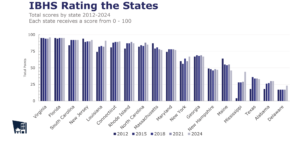Things are looking good for property/casualty insurers writing specialty business. Specialty lines premium has about doubled as a share of overall commercial premium in the 21st century, judging by A.M. Best figures for surplus lines, where a large share of specialty business is written. The global specialty market is projected to grow nearly 6 percent per year through 2028.
Executive Summary
The specialty lines business may be small, but the margins can be impressive where carriers are successful at it. Being successful requires understanding certain peculiarities and honing a special discipline toward product development.Yet no carrier can afford to jump into the business or expand an existing specialty option without thorough consideration of what it takes to succeed. Even with robust growth, specialty insurance remains a small fraction of total U.S. property/casualty premium—perhaps less than 10 percent, depending on how “specialty” insurance is defined.
No matter how it is defined, specialty lines business is where “scale is small but margins sometimes higher,” to borrow a phrase from Mark Watson, president of specialty writer Argo Group. Watson adds that “it takes a huge investment of time and talent to be able to understand the peculiarities of any specialty business.”
Apart from having to assemble underwriting and claims expertise to manage the “peculiarities” of a market niche, a successful specialty lines operation has a discipline of its own, which includes the ability to develop flexible policy forms and use non-traditional data in rating coverage; the ability to add risk management and loss control services, both to limit losses and secure accurate information for underwriting and pricing; and the ability to quickly assemble, deploy and redeploy the resources needed to execute these functions.
Standard Opportunities
One thing beckoning insurers to the specialty market is a growing demand for new coverages for accounts already insured under standard lines.
In the area of first-party property, more and more specialty writers are providing coverage for economic losses that do not require any physical loss to tangible property.
“As life changes, people develop new expectations about what should be insurable,” said Terri Hitchcock, director of product design for Perr &Knight, an actuarial and operations consulting firm for P/C insurers. “For some emerging products, regulators will ask if they qualify as insurance, or if instead they are something like warranty products or service contracts.”
One emerging product broadly accepted as insurance is “non-damage business interruption” (NDBI), a recent example of which is Marsh’s “Social Unrest Insurance Solution.” Launched in October 2018, the Marsh program provides coverage for loss of income whenever an insured is denied access to its properties due to protests, demonstrations or disturbances, as well as acts of sabotage or terrorism, whether or not there is property damage.
 Cyber insurance is the fastest-growing type of specialty insurance, to the point that cyber coverage is rapidly becoming standardized. Besides covering losses to intangible data and computer networks, cyber insurance is spreading the popularity of insuring loss to “reputation” as a common type of coverage.
Cyber insurance is the fastest-growing type of specialty insurance, to the point that cyber coverage is rapidly becoming standardized. Besides covering losses to intangible data and computer networks, cyber insurance is spreading the popularity of insuring loss to “reputation” as a common type of coverage.
In the cyber context, loss to reputation refers to a reluctance on the part of consumers and organizations to do business with an entity compromised by a data breach or cyber attack. The coverage usually entails reimbursement of costs for public relations and related efforts to restore an organization’s reputation but can also include loss of income due to reputational damage.
Reputational coverage applies beyond cyber insurance, however. In February 2019, AGCS Allianz released its Reputation Protect Plus program in the United Kingdom. The program provides crisis communications funding and support while also covering the loss of operating profits.
Loss of Attraction
Coverage for reputation is essentially coverage for the effects of subjective opinions, apart from consideration of any objective damages. Similarly, there are now “loss of attraction” policies covering retail and entertainment establishments for a downturn in business that occurs as patrons avoid a location in the wake of a violent act or some other traumatic event.
In response to mass shootings in recent years, several insurers and program administrators have introduced “active shooter” or “violent acts” programs to help insureds respond to and recover from an attack. Common components of these programs include first-party coverage for loss of earnings due to a disruption of operations during an incident, as well as loss of attraction following the event.
McGowan Program Administrators, a leading provider of violent acts coverage, introduced coverage for replacing an undamaged or barely damaged structure in the event it became unusable for its intended purpose because of a traumatic event.
“We have an active shooter/workplace violence property program that will pay for the refurbishment, teardown or rebuilding of a property, or the cost of memorial due to mental anguish,” said Paul Marshall, managing director of McGowan’s active shooter and workplace violence programs.
“There doesn’t have to be any property damage [to trigger the coverage],” he said. “This coverage is becoming more and more popular as people realize the severe costs of recovering from such events.”
Expenses and Services
Violent acts/active shooter programs are examples of two other common characteristics of emerging specialty programs: coverage for expenses in the wake of an incident, even in the absence of an actual loss; and the provision of ancillary services for risk management, loss control and loss recovery.
Those types of services are an important component of the specialty strategy of OneBeacon Insurance Group, another leading specialty carrier, according to Jeff Richardson, the group’s senior vice president of specialty.
“These services are a compelling, differentiated benefit for certain customer groups, such as entertainment, technology or public entities,” he said. “Risk control consulting gives us a clear line of sight to the potential [level of] risk on a particular account while presenting an opportunity to collaborate with clients.”
“This capability, augmented by some third-party resources, lets us compete for good business while positively impacting our customers’ bottom line,” Richardson noted.
Liability Trends
The most potential premium in specialty lines lies in “other liability” business, which A.M. Best estimates accounts for nearly half of surplus lines premium. Other liability includes some well-established specialty lines, most notably professional liability (or errors and omissions), management liability (or directors and officers), cyber liability (for third-party cyber damages), employment practices liability and environmental (or pollution) liability.
What’s new about these established specialty lines is their application to a growing range of accounts, many of which are already covered under standard policies and thus good candidates for a carrier to expand into specialty coverage.
For example, within the last 10 years Victor O. Schinnerer and Prime Insurance have developed E&O coverage for artisan contractors (carpenters, plumbers, electricians, etc.), a class of business where liability coverage was previously limited to bodily injury and property damage.
The expansion of E&O exposure and coverage to artisan contractors reflects the growing specialization of knowledge outside of traditional professions and an expectation that people in more and more occupations demonstrate a standard of “professional” knowledge and care beyond what was traditionally expected.
At the same time, traditional areas of professional liability coverage have continued to develop new niches. In November 2018, Allied World, a leader in medical professional liability coverage, introduced a new program for insuring liability exposures of individuals and companies who provide consulting services to healthcare facilities.
Another trend in specialty liability has been the application of D&O insurance, originally developed to cover executives and board members of corporations, to small, privately held companies. OneBeacon, a leader in D&O coverage, recently introduced a streamlined program of management liability insurance for private companies, not-for-profit organizations and healthcare providers.
Data and Tech
Growing opportunities in specialty lines are related to a near-reversal of the relationship between specialty lines and technology.
In May 2019, the technology research firm Novarica observed that specialty carriers “have traditionally made less use of automation than insurers in other sectors.” It used to be that, if a carrier had the right product at the right price for the right risk, it could avoid the technological arms race that drove competition in standard lines.
Today, said Novarica, specialty carriers are “differentiating themselves in a competitive marketplace through investments in distribution (especially new business submission), product development, underwriting and claims.”
Specialty insurers are at the forefront of innovation in underwriting, pricing and claims management, using data captured through sensors deployed in the Internet of Things (IoT) to assess and monitor risk conditions and generally embracing InsurTech initiatives.
“Innovation has become an expected attribute across all business sectors,” said Kevin Gallagher, senior vice president of business development and capital management for OneBeacon Group. “Frankly, being creative and forward-thinking has always been a key success factor for specialty carriers. By anticipating emerging business trends and then refining appropriate coverages to address these new risks, we balance offering ongoing support to current customers while carving out new markets.”
Some specialty policies actually condition coverage on the activation of particular loss control measures or technologies, said Hitchcock at Perr &Knight, who added that the integration of data from sensors installed in vehicles and buildings to monitor risk conditions (speed, temperature, moisture, pressure, etc.) is prompting reconsideration of long-standing restrictions on rebates and discounts in insurance.
“In the past, providing value-added products or services and sales incentives was frowned upon,” she said. “But regulators are starting to recognize the benefits of encouraging applicants and insureds to take advantage of risk mitigation devices and smart home devices.”
While regulators are increasingly receptive to insurance programs linked to risk technologies, she cautioned insurers not to underestimate the time and effort needed to establish and justify such links.
Margin Challenge
Nothing worth doing is ever easy, however, and the developments that make specialty lines underwriting more efficient have their own obstacles and challenges.
For all the possibilities data analytics and technology bring to specialty lines, the core condition cited by Watson at Argo remains: Small-volume specialty lines need to generate large margins to justify the allocation of resources required to develop and maintain them. Thus, an internal challenge for carriers is to convince managers of the wisdom of devoting staff and IT resources to small markets.
It follows that what’s easier today for one carrier is also easier for its competitors, so the difference between success and failure is measured at the margins. In particular, there will always be a competitive need for ever more data at an ever more granular level.
The demand for data complicates an already delicate relationship between a carrier and its distributors. “Getting broker and MGA partners on board with insurer portals is a ‘work in progress,'” wrote Mitchell Wein, Novarica’s senior vice president of research and consulting. “Most brokers continue to want to do business out of their own agency management systems rather than carrier portals, and many are looking for more control over data.”
Control over data cuts to the heart of the value of specialty operations, as they are often prized as targets for acquisition.
According to Wein, many carriers are implementing cloud-based platforms for integrating real-time data exchange with their producers, but “email and telephone will remain key technologies to conduct business for many specialty lines for the foreseeable future.”
Finally, the care and feeding of a specialty lines operation intensifies a challenge all insurers face: recruiting and retaining qualified talent.
In specialty lines, where both insurance acumen and knowledge of target markets is essential to success, the “war for talent” often extends to the costly and unappealing practice of raiding your competition, knowing that you will be raided in turn.
So, opportunities are abundant in specialty lines, but the challenges to success are dogged and enduring.





















 GEICO Tops List of Mobile Insurance Apps
GEICO Tops List of Mobile Insurance Apps  Study: Average Cyber Breach Insurance Coverage Gap is 350%
Study: Average Cyber Breach Insurance Coverage Gap is 350%  Progressive Gains as Drivers Shop Around for Auto Insurance—Again
Progressive Gains as Drivers Shop Around for Auto Insurance—Again  Fitch: U.S. Cyber Insurers Saw Strong Profits, Slowdown in Premium Growth in 2023
Fitch: U.S. Cyber Insurers Saw Strong Profits, Slowdown in Premium Growth in 2023 




